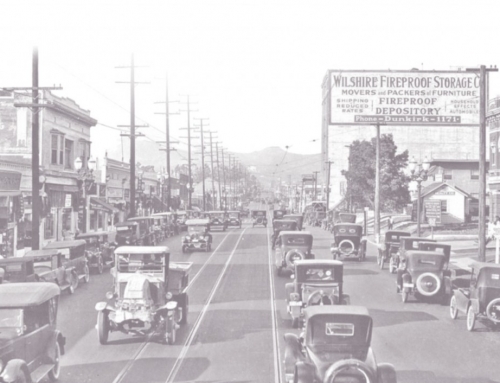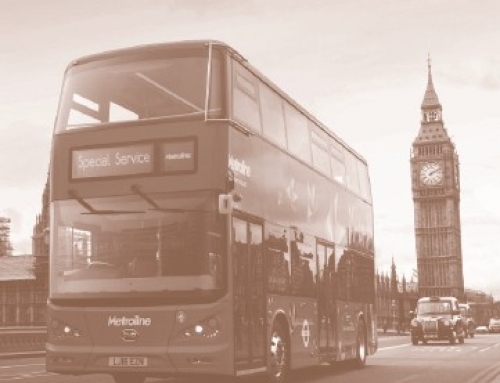[sharelines]Parking is the sacred cow of land uses.
Parking is the sacred cow of land uses. It claims privileged status in zoning codes and there is simply too much of it in cities. Previous ACCESS articles reveal problems with minimum parking requirements; show how excess parking harms livability, sustainability, and equity; and explain how pricing can manage its use. This article demonstrates that progress requires more than code reforms and better pricing; it requires coordinated, comprehensive parking management. We need to shift from building parking to managing it.
Parking is the sacred cow of land uses.
Figure 1 shows the result of parking’s privileged status: vast heat islands seldom used for their intended purpose. Future social trends and technological advances will disrupt the private vehicle ownership model, making these empty spaces even less justified. The question is how do we transition from too much parking to efficient use of a smaller parking supply? The answer is parking management.
Parking management uses a wide range of tools—parking sensors, pricing, regulations, and information systems—in an effort to use parking efficiently. Efficiency occurs, for example, where the most convenient spaces serve many different parkers per day and different land uses share all spaces. Said another way, parking management prevents spaces from seldom or never being used.
Every community that has a two-hour time limit for downtown curb parking is engaged in parking management. The problem is that parking management is ad hoc, infrequently adjusted, and uncoordinated. In most communities, parking management is a “set it and forget it” enterprise. Figure 2 shows a locale where this set-it-and-forget-it mentality has been in place so long that a tree grew around the parking sign. Even in America’s largest cities, a baffling, arbitrary, and non-optimal set of practices often manage on- and off-street parking spaces located in both private and public facilities.
As with any critique, the skeptic rightly asks, “how could this be?” There are three reasons for America’s lack of proper parking management. First, our cultural ideals embed the notion that parking should be a free and available right in front of any destination. The introduction of parking management can signify broader, highly charged social changes as communities become denser and traffic increases.
Second, the responsibility for parking is extremely fragmented. Cities, transit agencies, property owners, employers, commercial facilities, and parking operators all play important roles. Even within governments, parking responsibility is divided between the departments of public works, planning, economic development, finance, as well as the police. Few cities think about the big picture in a comprehensive way.
Finally, the oversupply of parking means that we have not had to manage it well. When there is too much parking everywhere, there is no need to efficiently direct parkers to a space that suits the length of their stay. Most zoning codes have forced up the parking supply, which creates artificially low prices that do not create an incentive for better management.
Parking management shifts thinking about parking spaces from objects to services. While two parking spaces may have identical dimensions, one may seldom be used while the other serves many users and many trips per day. The first space is practically useless; the second effectively supports automobile access to a district.
The best way to measure parking use is by measuring the share of total hours a space is occupied (during a day, week, or year). Better parking use means we need fewer parking spaces to provide a given number of parking space-hours. Thus, as communities grow, the parking supply can grow more slowly or even shrink.
Figure 3 shows how parking perceptions differ from reality. The first, largest circle represents the number of parking spaces that stakeholders think they need when there is no management. Transportation demand management (TDM) allows a district to function successfully with fewer parking spaces. The second, smaller circle represents the number of parking spaces needed after conventional TDM. This reduction in spaces occurs, for example, when cities charge for parking and some drivers shift to carpooling, walking, biking, or transit. The third, smallest circle represents the number of spaces needed when better parking management more efficiently uses the spaces we already have.
Fortunately, there has been an explosion of techniques and technologies that facilitate parking management. Sensors can determine parking occupancy. This real-time information can reduce search times, allow sophisticated pricing schemes, and support efficient enforcement. Parking meters can vary price by time of day and parking duration to encourage space turnover. Meters that accept credit cards or smartphone payments eliminate the hassle of finding quarters to pay for parking.
The other piece of good news is that cities are increasingly adopting parking pricing for on- and off- street spaces. This aligns the drivers’ costs with the broader social costs of accommodating cars. Parking pricing encourages the use of alternative travel modes and can achieve space occupancy goals by dynamically varying prices to achieve space availability on every block. Dynamic pricing projects in Los Angeles and San Francisco use time-of-day pricing and frequent price adjustments to achieve space occupancy goals.
Combining parking pricing with new technologies will help resolve the parking management issue. Unfortunately, these tools alone are not enough. We need collective action when markets don’t function properly, such as when landowners don’t respond to price signals because they are unaware of profit opportunities from sharing their parking. Planners may need to persuade property owners about the benefits of parking management, or give assistance in managing their parking.
The best solution is comprehensive and coordinated parking management. Improved management maximizes shared parking, uses parking prices to allocate spaces to parkers, and provides choices, predictability, and reduced search time for parkers.
Parking management requires a strategic plan that goes beyond traditional planning for parking. Plans must call for policy makers to engage with multiple organizations, not just one. These organizations must collaborate, design operating protocols, and perform assessments. Strategic plans should also include elements that are programmatic, which means that they can start as pilot projects and be adjusted in response to conditions. Changing meter prices or “loading zone” dedications is much easier than building or tearing down a parking structure.
Stakeholders often think of parking management options in ways that align with their background or expertise. Someone trained in economics is likely to think of pricing strategies. Someone trained in education and marketing may think about information systems. In Figure 4, Box 1 provides examples of strategies that an engineer might envisage, such as advanced parking equipment. Box 2 presents the pricing techniques used by an economist. Box 3 displays parking rules that reflect a regulatory approach. Finally, Box 4 contains education and marketing strategies.
Parking managers should consider all four approaches. They may not all apply, but a multi-pronged approach in which strategies are coordinated will be more successful than any one strategy. There may also be connections (and tradeoffs) between approaches. For example, dynamic pricing (Box 2) requires advanced parking equipment to support the pricing algorithm (Box 1). This equipment works best if parkers have apps that guide them to the location and price they want (Boxes 2 and 4). Rules about who gets to park in what space are likely still required for special parking uses, such as locations where curb parking is permitted (Box 3). Education is also essential to avoid the negative perception that this is just a money grab by the city (Box 4).
Portland-based parking consultant Rick Williams argues that an integrated management entity can best coordinate parking strategies. Some cities create a parking authority and achieve a high level of coordination between private and public parking. Other cities form joint authorities with transit agencies to cooperatively manage parking resources as well. Williams outlines the following steps for creating a managed, integrated, and financially sustainable parking district.
- Establish management principles
- Create organizational structure
- Define roles for on- and off-street parking
- Establish rate-setting protocols
- Measure performance
- Communicate how the integrated parking system works
- Evaluate new technologies
- Conduct financial analysis for ongoing management
As cities consider a future economy that emphasizes use rather than ownership, and services rather than facilities, many are innovating in parking management. In addition to Los Angeles and San Francisco, cities representing a full spectrum of sizes and locations are following suit: Redwood City, CA; Pasadena, CA; Boulder, CO; Washington, DC; Portland, OR; Seattle, WA; and Tacoma, WA.
Meanwhile, several emerging trends suggest that parking use rates will decrease in the future. This shift is due to new services (such as shared-ride mobility), alternative arrangements to owning a car, and improved transit, walking, and bicycling options. Land use changes such as mixed-use developments will have a similar effect, while preferences for an auto-free lifestyle may reduce parking use as well. Furthermore, technology can reduce driving (such as online shopping), and self-parking cars reduce the space needed per parked vehicle.
The best strategy for creating a managed, integrated, and financially sustainable parking district is to start with an appeal to broader community goals. Show how parking management supports revitalization. Educate stakeholders, especially by showing them how parking management works in communities that are similar to theirs. Appeal to people’s self-interest, such as when parking pricing produces revenue for street improvements or public amenities. Finally, find allies, like multimodal transportation advocates, infill and affordable housing developers, small businesses, and historic preservationists. All of them can help strengthen the case for parking management.
Parking management is the key to smart growth. As we shift toward providing parking as a service rather than as an object, so must we shift from building parking to managing it. We can manage parking more efficiently by ensuring that its price aligns with the value it provides. Parking management is right on time for this new era.
This article is adapted from the book, Parking Management for Smart Growth, published by Island Press.
Further Reading
Donald Shoup. 2011. The High Cost of Free Parking, Chicago: Planners Press.
Richard W. Willson. 2015. Parking Management for Smart Growth, Washington, DC: Island Press.
Richard W. Willson. 2013. Parking Reform Made Easy, Washington DC: Island Press.










